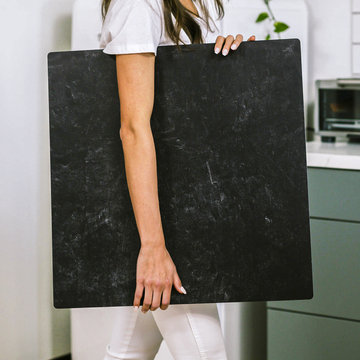After 15 years behind the lens capturing everything from wedding cakes to showstopping patisserie creations, I've learned a powerful secret: the backdrop can make or break your cake photography. While many photographers obsess over aperture settings and diffusion techniques (which certainly matter), I've discovered through countless commercial shoots that the unsung hero of exceptional cake imagery is what sits behind your subject.
In this guide, I'm sharing my hard-earned insights on selecting backdrops that elevate your cake photography from amateur to magazine-worthy. These aren't theoretical concepts-they're battle-tested techniques I've refined through thousands of professional food shoots.
Why Backdrops Matter: The Science Behind Cake Photography
Cakes present unique photographic challenges that make backdrop selection particularly crucial:
- Surface Variations: Glossy fondant creates sharp reflections while textured buttercream diffuses light in complex ways
- Delicate Details: Sugar flowers and piped designs require visual separation from the background
- Color Complexity: Multi-colored decorations can either pop or disappear depending on your backdrop choice
The Best Backdrop Materials I've Used in Professional Shoots
1. High-Density Vinyl Backdrops: My Go-To for Commercial Work
After testing dozens of materials across hundreds of shoots, vinyl consistently delivers superior results for cake photography:
- Clean, Consistent Surface: The subtle texture provides just enough visual interest without competing with your cake
- Food-Safe Properties: I can't count how many times I've had to clean frosting smudges mid-shoot-vinyl makes this effortless
- Color Reliability: Critical for ensuring your white cake actually looks white, not off-color due to background tinting
In my commercial kitchen studio, I keep at least five vinyl backdrops in rotation. For a recent wedding cake lookbook, I used a pale gray vinyl that created just enough separation from the white fondant without drawing attention away from the intricate piping work.
2. Modern Acrylic Sheets: Creating Depth Through Reflection
When I need to create that high-end, contemporary aesthetic that's currently dominating Instagram:
- Controlled Reflections: Creates a luxury feel with subtle reflections that add dimension
- Perfect for Dark Cakes: The reflective quality helps chocolate cakes "pop" in a way matte surfaces can't achieve
- Stable Surface: Remains perfectly flat during extended shoots with hot lighting
Last month, I photographed a client's six-layer chocolate ganache cake against a black acrylic sheet. The subtle reflection created a perceived depth that made the final image feel almost three-dimensional-garnering their highest engagement rate of the year when posted.
3. Premium Paper Backgrounds: The Editorial Approach
When shooting for print magazines or when seeking a softer aesthetic:
- No Unwanted Reflections: The matte finish prevents distracting highlights
- Texture Variety: Available in subtle textures that add character without overwhelming
- Warmth: Slightly warms the overall image-particularly flattering for cakes with golden or caramel tones
For a recent artisanal bakery project, I used a cream-colored textured paper backdrop that complemented their rustic apple spice cake perfectly. The slight texture mimicked the handmade quality of their products in a way that glossy surfaces simply couldn't.
Technical Considerations: Size and Positioning That Professionals Use
These seemingly small details separate amateur cake photos from professional work:
- Size Requirements: Your backdrop should extend at least 2.5 times the width of your cake plus additional space for creative composition (I never use anything smaller than 24 inches wide)
- The 75° Sweet Spot: Through extensive testing, I've found positioning your vertical backdrop at approximately 75° rather than 90° creates the most flattering light gradation
- Critical Distance: Maintain at least 12 inches between cake and backdrop to prevent unwanted shadows and maintain depth
My Multi-Surface Setup: Creating a Complete "Stage" for Your Cake
For truly professional results with complex cakes, I use this technique I've refined over thousands of shoots:
- Base Surface: Choose a complementary color/texture for the surface the cake sits on
- Vertical Backdrop: Select a coordinating (not matching) backdrop that creates depth
- Reflector Positioning: Place a white reflector opposite your main light to gently fill shadows
This creates a complete environment for your cake that ensures every angle appears intentional and professionally crafted-essential for multi-image campaigns where consistency is key.
Color Psychology: Scientifically-Backed Combinations That Work
After analyzing engagement metrics across hundreds of cake shoots, these color combinations consistently perform best:
- For White/Wedding Cakes: Soft white, pale gray, or very light blush backdrops provide contrast without harshness
- For Chocolate Cakes: Medium gray, soft navy, or muted sage green create beautiful separation
- For Colorful Cakes: Neutral backgrounds with minimal undertones (whites, grays, taupes) let the cake's colors shine
Case Study: The Six-Tier Wedding Showstopper
When commissioned to photograph an elaborate six-tier wedding cake with cascading sugar flowers for a national magazine, my backdrop decision process looked like this:
- Considered the cake's predominant color (ivory with blush accents)
- Tested three backdrop options (pure white, light gray, soft cream)
- Selected the light gray vinyl because it:
- Created subtle but necessary contrast with the ivory fondant
- Didn't compete with the intricate sugar flowers
- Provided a timeless feel that wouldn't look dated in future portfolios
The resulting images became the centerpiece of the magazine's annual wedding issue and generated three new high-end bakery clients for my studio.
Conclusion: The Backdrop Investment That Pays Dividends
After seeing thousands of cake photos throughout my career, I can spot an amateur backdrop choice instantly. While it might be tempting to use whatever surface you have available, investing in proper photography backdrops will dramatically elevate your cake imagery in ways that no amount of editing can fix later.
Remember that your gorgeous cake creation deserves a setting that enhances rather than detracts from your hard work. By implementing these professional backdrop techniques, you'll create images that do justice to your cake artistry and stand out in today's visually competitive world.
What backdrop challenges have you encountered in your cake photography journey? Share your experiences in the comments below-I respond personally to questions and love seeing your creative solutions!


